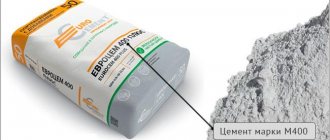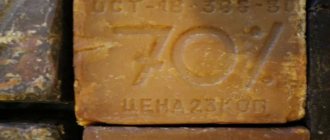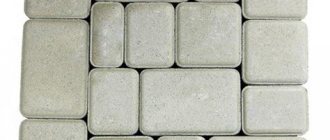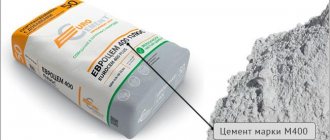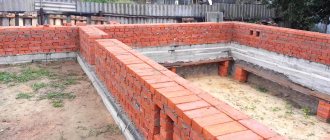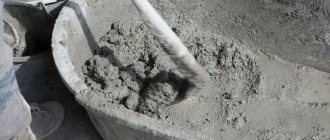Home |Construction |Antifrost additives in brick mortar
Date: November 14, 2017
Comments: 0
The construction of buildings is carried out at an accelerated pace and does not stop in winter, despite worsening weather conditions. Winter construction has a number of advantages, as materials become cheaper and it is easier for vehicles to move on solid ground. However, there is a serious problem associated with the delayed hardening of the mortar used for masonry. Experts say that if bricklaying is done in winter, additives are necessary. They reduce the threshold for water crystallization and accelerate hardening.
Freezing method
The method is applicable for the construction of buildings up to 4 floors and a height of ≤ 15 m. The essence is to use conventional mortars to ensure their initial setting, which is ensured by heating water to 80 degrees and sand ≤ 60°C, further strengthening occurs upon the onset of thaws.
The following requirements must be strictly observed:
- at the time of installation, the temperature of the solution should be: with an average daily temperature of up to - 10° - plus 5°; to minus 20° - +10° and 15° at temperatures below -20°C. In the first 2 cases, a grade of mortar is used higher than the design one by one; in the third, the excess should be two grades;
- Bricklaying in winter is carried out throughout the entire area at the same time;
- per mile, the mortar is laid immediately on a maximum of two adjacent bricks, on a backfill ≤ 8;
- the finished solution should be applied for ≤ 30 minutes;
- the mason's mortar container must have a lid, be heated or insulated;
- a frozen solution cannot be used; heating it by adding hot water is unacceptable;
- It is prohibited to remove frozen ice crust on the walls with hot water; you can use a blowtorch or hot steam, which will additionally heat the bricks;
- after completing the daily laying, the grip is covered with heat insulators;
- Before the thaw, everything unnecessary (equipment, tools, building materials and debris) is removed from the floors.
Walls, floors and beams
When walls or pillars are erected, it is necessary to make masonry of the entire building, as a border, a seam may protrude, which is sedimentary. The height of the structure in such conditions should not be more than 4 m. When the masonry is ready, floor slabs must be placed on it immediately. All beams, as well as purlins that rest on the walls, must be connected using metal anchors. So, the entire structure will be able to withstand the weight of the plates pressing from above. The purlins are secured with twists, or if they are wooden, then with the help of overlays. Only correct brick laying and proper fastening will give a positive final result.
The base for the foundation is laid out, protecting everything from freezing, both during and after work. This is necessary so that the foundation does not begin to rapidly sag during thawing, thereby subjecting the masonry to deformations that can lead to collapse. In winter, roofing felt, roofing felt, or polyethylene are laid on the plinths directly on a leveled concrete bed. They are laid in three layers, or more, the main thing is to contain the effects of frost.
Types of additives, classification by action
Additives are produced in the form of powders and liquids, ready for use. There are concentrated solutions that are diluted before administration. The types of additives according to their effect are defined in GOST standards 24.640 - 1991 .
Main varieties:
- plasticizing agents;
- mixture setting accelerators;
- air entrainers;
- hardening retarders;
- inhibitors of corrosion processes;
- seals;
- antifreeze additives;
- decorative dyes.
There are different types of masonry, each of them requires a composition with certain qualities. Based on this, the required modifiers are selected.
Plasticizers
Used to produce winter masonry mortar for bricks, which has increased mobility . In addition, density, resistance to freezing, and water absorption increase.
- Reduce the consumption of cement binder by 10 – 15%
- Reduce water concentration by 5 – 15%
- Reduces shrinkage after setting
- Increases resistance to temperature changes
- Increases the adhesion of the mortar to the reinforcement bars
- Reduce the risk of corrosion on the stamping mesh in the masonry and metal embedded parts.
In the plasticized mixture, fewer air cavities appear that affect strength. The material does not delaminate, increasing the storage time of the mixture before laying it into a brick wall.
Accelerators
The purpose of use is indicated in the name of the additive - the substances promote rapid hardening of the mortar mixture . The additive is relevant because when the air temperature drops, the process slows down and stops in cold weather. Thawing a mixture that has not set is fraught with deterioration in quality and the appearance of cracks.
Associated action of accelerators:
- increase mobility, strength;
- increases resistance to moisture absorption by 20–25%.
The product is sold in the form of a liquid or dry powder, which is diluted with water before being added to the mixture. The dosage is written on the label, but is usually used in a concentration of 0.2 - 5.0% of the total weight . Accelerators are used not only in cold weather, but also when it is necessary to quickly build large-volume brickwork.
The additive accelerates the development of strength of the mixture, so there is no need to wait the required 28 days for this.
Accelerating modifiers contain aggressive substances, so they are not used in reinforced masonry or combined with other additives.
Anti-frost
The action is aimed at accelerating the hydration of cement at sub-zero temperatures . Chemicals allow the solution to immediately gain 30% strength, maximizing the involvement of water in this process. Then the mixture freezes without gaining 100% strength, but this amount is enough to prevent the process of delamination from starting when defrosting.
Masonry on mortar with such additives cannot be immediately loaded so that the mixture can gradually mature without the appearance of internal stress. Antifreeze additives increase the adhesion of the mass to metal bookmarks and reinforcement, because at subzero temperatures the solution does not envelop the rods and adhesion does not occur.
Reinforcing
The inclusion of fibers in the mortar mass increases its susceptibility to forces, so the strength of the brickwork increases . The solution is characterized by resistance to loads, but does not work well in bending and stretching. Because of this, cracks appear in the wall during shrinkage.
Effect of reinforcing additives:
- fills the gaps between cement grains, increases wear resistance;
- increases the service life of the structure;
- gives smoothness to the hardened mortar, eliminating microcracks.
Fiber tanks are produced on the basis of steel, basalt and polypropylene threads.
Decorative
Additives pigment the mortar mass to create a colored seam between individual wall elements. They are added to brick mortar in winter to increase the attractiveness of the structure.
Heating seams using electricity
There is also a technology for laying bricks with heating. To do this, you need to lay wire in the horizontal seams. Its thickness can be 0.3-6 mm, and you need to leave the ends long enough to be able to conveniently connect to a current source. It can be a welding machine. When laying the wire, you need to make sure that there are no voids in the solution, because heating in this case will be slower and may become ineffective.
Only 25% is spent on heating the mixture itself; the rest of the energy is spent on heating the brick and the surrounding air. Therefore, it is worth carefully choosing a device that is capable of consistently delivering the required amount of electricity. This kind of brickwork, the diagram of which is outlined here, is the most technologically advanced, and much more modern than the one where you need to build hothouses.
Masonry mortar
Masonry does not lose its strength in winter conditions if you prepare the cement mixture correctly. They are distributed by brand. In the cold season, you need to choose a solution of M50 or higher. It includes sand and cement. Next, dilute with water to the required consistency. Water cannot be added to the hardened mixture. It is important to pour not the entire mixture at once, but only the amount that will be produced per day. It should not be too liquid to avoid voids and not increase consumption. The temperature of the masonry mortar is regularly measured throughout the entire period of work. If the air t is -10, then the solution should be +5 degrees, and when the street is from -10 to -20, then the mixture is maintained at +10 degrees.
Winter concreting
Recently, the consulting department of our company has quite often begun to receive calls with questions - how to lay concrete in winter, what kind of concrete to use, is it worth using anti-frost additives in concrete or is it better to arrange electric heating? Let's try to briefly describe the main methods of winter concreting.
Low temperature is the main problem accompanying winter concreting. To begin with, it is worth mentioning how negative temperatures can affect the process of setting and hardening of concrete. There are two main reasons:
- Slowing down the process of cement hydration (increasing the time it takes for concrete to gain strength)
- Freezing of water contained in concrete (complete stop of the process of strengthening)
Let's look at it in order: how each of the reasons affects the behavior of concrete gaining strength. What is the main problem of concreting at low temperatures? Why is negative temperature dangerous for freshly laid concrete? What exactly does cement lack for proper setting and formation of cement stone when concreting in winter?
Low temperature (0+10 degrees) significantly slows down the process of cement hydration. Simply, the time frame for concrete to gain strength is extended. For example: under normal conditions (+20 degrees Celsius), concrete gains up to 70% strength in a week. At an ambient temperature of +5 degrees, the period for gaining 70% of the brand strength of concrete can take 3-4 weeks.
High temperature is a catalyst for most chemical processes. The process of cement hydration is no exception. That is why, in the manufacture of reinforced concrete products, steaming of freshly cast concrete products is used. During steaming, in the chamber with freshly made reinforced concrete products immersed in it, a temperature of 70-80 degrees and high humidity are maintained. Thanks to such conditions, concrete gains grade strength at an accelerated pace. And concrete can gain the notorious 70% strength in 8-12 hours (under standard 20-degree conditions, similar concrete strength is achieved in a week).
And if a low positive temperature slows down the process of setting and gaining strength of concrete, then a negative temperature completely stops it. The reason for this is the freezing of water in young concrete. The process of cement hydration itself is impossible in the absence of water. Water is a necessary component for the formation of cement stone. The cement must be in contact with water (moisture) during the entire maturation period.
The classic period for gaining brand strength of concrete is 28 days. It is at this age that it should gain strength, which was calculated and predicted by the laboratory of the concrete plant. However, as we have already found out, when concreting in winter conditions, the process of setting and gaining strength can be extended, or even stop completely, until the onset of a thaw.
How to concrete in winter
Since we are talking about winter concreting, we will assume that the temperature at which we carry out monolithic work is negative. The main task is to prevent the water contained in the concrete from freezing. As the ad says, “Don’t let yourself dry out.” In this case, do not let the cement dry. Cement needs water. This is his life and his strength. In fact, winter concreting technology is aimed at preserving water from freezing (crystallization).
What methods of winter concreting are most often used on modern construction sites? There are several main ways to preserve concrete mixing water from freezing:
- Application of anti-frost additives in concrete (AMD)
- Using electric heating of concrete
- Covering concrete with PVC film, insulation, etc.
- Construction of a temporary shelter with heating using heat guns
The use of antifreeze additives in concrete is the most common method used when concreting in winter conditions. Most concrete plants produce concrete with winter PMD additives. The so-called winter concrete is produced in various variations, differing in the percentage of additives.
Antifreeze additives are introduced into concrete in a strict percentage ratio with the amount of cement included in a particular brand of concrete. Also, the amount of anti-frost additive depends on the expected air temperature at which concreting will take place. Read more in the section Anti-frost additives for concrete.
Features and Issues
If it is not possible to transfer stone work to warm weather in winter, the following factors should be taken into account:
- Laying bricks in frost is technologically more difficult than at above-zero temperatures.
- The duration of hardening of the cement mortar increases 3-4 times if the air temperature is 15 degrees.
- Cement mortar will not harden at zero temperature.
- Cold reduces the structure, elasticity and strength of the mixture.
- Ingress of moisture can damage the integrity of the brick.
- Gives uneven precipitation during thawing.
- At -20, masonry is not recommended, while at -30 it is strictly prohibited.
- Winter construction costs are 30% higher than summer construction costs.
In winter, you can lay bricks, but you need to monitor the quality of the cement mixture. Winter bricklaying is not complete without an additive that increases strength.
If work began in the warm season and did not end with the onset of winter, it is not advisable to postpone construction by six months. In addition, it is difficult to predict how long the subzero temperature will last. With the onset of frost, the composition of the cement-water solution changes, which significantly increases the cost of the process. An important factor is uncomfortable working conditions in winter.
Is it possible to add salt to concrete: advantages and disadvantages of use
Quite often, when making various compositions or mixtures, professional craftsmen use components in the form of salt, which should give it additional qualities. At the same time, various disputes constantly arise about whether this should be done and in what proportions. Therefore, the question of why salt is added to concrete and how much is needed to achieve the desired result is of great concern to novice specialists.
Amateur photo of the consequences in the form of stains from rusting reinforcement and sedimentation on the surface when using salt in a concrete solution
Advantages and disadvantages
In order to resolve this dispute, it is necessary to consider all the advantages and disadvantages of this method and draw a conclusion based on them. At the same time, the question of how much salt to add to concrete should be answered only if the research result is positive.
The consequences of using salt as an additive during winter installation affect not only the appearance, but also the strength
Cement-lime mixture
Cooking method
The solution is easy to make!
In normal summer conditions, at above-zero temperatures, a standard mixture is used, which is prepared with your own hands, according to time-tested technology (see
To create it you need:
- Lime.
- Sand.
- Cement.
The first step is to create the so-called lime paste, which is made by mixing lime and water. After this, the resulting gruel is filtered through a fine sieve.
In parallel with this, a mixture of sand and cement is mixed separately. Lime paste and some more water are already poured into it. It is precisely this mixture that is used to fasten the brick structure. However, in winter everything is different.
Effect of frost
What happens to the solution in the frosty season? The thing is that the slurry that holds building bricks together contains a considerable amount of water, which in a liquid aggregate state perfectly performs its binding function.
But as soon as the temperature passes zero, the water turns into ice crystals, which destroy the entire structure of the lime-cement mortar.
Based on this state of affairs, several methods have been invented to make it possible to carry out masonry during the frosty winter period. One of them is the preparation of a special winter mixture.
Requirements for mixture components
When preparing a solution, special attention is paid to the quality of the components. The water for the solution should not contain impurities, oils, or dirt. Well and spring water shows the best results. If the mixture is prepared in summer, then the water should be cold, i.e. not heated by direct sunlight, but in winter, on the contrary, it needs to be heated a little. The sand used is well cleaned and sifted. It should not contain clay or impurities. Cement determines the basic properties, so it should be checked especially carefully. When purchasing, you should ensure that the packaging has not been damaged. Cement that has been stored in a humid atmosphere is unusable. Lime should be used in slaked form. Detergents can be used: almost any shampoo, washing powder, etc. Cleaning agents alone should not be used.
Return to contents
Difficulties in laying bricks in frosty weather
The difficulty of winter masonry that determines all problems lies in the freezing of the cement mass, or rather the water contained in it. This disrupts normal hydration processes and the strength of the solution loses about a quarter of the required norm. This circumstance leads to inadequate adhesion of building elements, which directly affects the overall stability of the building. It decreases, and this can lead to unpleasant, sad consequences.
In addition, changes in temperature and humidity will cause:
- destruction of the structure of bricks from the process of freezing moisture in them;
— formation of a thin ice crust on the surfaces of the elements being connected;
- the formation of numerous voids in the solidified solution after temperature normalization.
Finding, let alone living in such a house becomes dangerous.
Attention! If you correctly follow some “winter” principles of laying bricks, then there will be no problems with quality construction and the structure will be reliable!
Finishing work
After erecting a brick wall to a level no higher than one floor, it is necessary to install prefabricated floors. If the masonry is carried out using the freezing method, the height of the erected structure in winter should not exceed 15 m.
In addition, it is extremely important to monitor the masonry once the thaw arrives. In order to provide additional stability and strength to the brickwork in the spring, it is necessary that the distance between it and the transverse walls does not exceed 20 m. In addition to all of the above, the walls on the south side must be covered with glassine or moistened.
Undoubtedly, laying bricks in winter is a labor-intensive and serious process, but if construction took place at the beginning of winter, you should not postpone it for as long as 3-4 months. If the sequence of work and methods of its implementation are followed, winter masonry will be no less durable than summer masonry.
Methods for laying bricks in winter
In difficult winter conditions, the following brick laying methods are used:
- using a solution with antifreeze additives;
- freezing of brick buildings;
- electric heating;
- laying bricks in greenhouses;
- thermos method.
Preparation of mortar for masonry
First of all, you need to know about the composition of the mortar that is used for laying bricks in winter. It is necessary to use cement with a grade no lower than M75-M100; the higher the number, the stronger the building will be. In addition, various antifreeze additives are used: sodium nitrite, potassium carbonate (potash), sodium formate, calcium chloride, sodium chloride. All of them contribute to increasing the strength of the masonry.
Controlled shrinkage
When laying in winter, reinforced concrete lintels are used, and if the spans are no more than 1.5 m, then ordinary lintels can be used for suspended formwork. This is everyday practice. Also, bricklaying standards provide for resting the formwork on racks, which are installed on wedges, and when the thaw sets in, they are weakened. Thus, allowing the entire structure to settle evenly. All racks and lintels are installed in the central parts of the walls; they must not be allowed to move. After everything has thawed, the formwork is removed from the lintels only after 15 days.
Winter masonry is also different in that the height of window and door openings, when they are laid out of brick, should be 5 mm higher than during similar work in the summer. In any case, the solution is mixed only in heated water.
Methods for winter bricklaying
To ensure that a house made of brick at sub-zero temperatures remains strong and durable, five common technologies are used:
- Method of heating masonry with electricity;
- Construction of thermal protection around brick walls;
- Thermos method;
- Addition of chemical frost-resistant additives;
- Frozen solution method.
Each of the methods may be relevant in one case and completely unacceptable in another. Let's look into everything in more detail.
Anti-frost additives for bricklaying in winter - types and advantages
The need to introduce additives is associated with the crystallization of water at low temperatures. Water increases in volume, causing destruction of the structure of the massif. The solution hardens for a long time and becomes covered with a network of cracks, which negatively affects its strength. This problem can be easily solved. Professional builders have no doubt that it is advisable to introduce additives into concrete in winter.
Very often, workers have to deal with the situation of completing construction in bitterly cold conditions, which is especially important for the northern regions of the country
The antifreeze additives used are classified into the following types:
- compositions that provide accelerated hardening. This group includes mixtures with organic components, as well as special solutions that contain acids;
- additives with antifreeze characteristics. They are made on the basis of calcium chloride. Provide accelerated setting of the mixture used for the construction of walls;
- ingredients that reduce the temperature threshold for water crystallization. The introduction of components such as sodium nitrite and potash allows the construction of brick walls at low temperatures;
- additives, the introduction of which provides significant heat generation with simultaneous acceleration of setting. This is ensured by the addition of iron and aluminum based sulfates.
If concrete is poured in winter, the additives included in its composition allow the solution to be used at subzero temperatures.
Antifreeze additives have a complex of serious advantages:
- lower the temperature threshold for water crystallization. This makes it possible to ensure a planned set of hardness and guarantee high performance characteristics of the cement mixture, as well as the strength of the brickwork;
- provide accelerated achievement of the strength of the solution and increase its water-repellent characteristics. Brick walls built using modified mortars have a long service life;
- increase the plasticity of the cement composition. This greatly facilitates the implementation of construction activities for laying brick walls, since it is much easier to lay bricks on movable mortar;
- protect reinforcement frames and metal meshes from destruction as a result of corrosion processes. Some additives contain special ingredients that provide the anti-corrosion characteristics of the modifier.
Adding additives to the solution in winter - general requirements
When adding additives to a cement mixture, you must adhere to the following recommendations:
- follow the manufacturer's recipe indicated on the packaging. The correct dosage guarantees the performance properties of the composition;
- take into account the ambient temperature and possible changes in weather conditions. Depending on this, it is necessary to adjust the concentration of additives;
- strictly follow safety requirements, use safety glasses, protective clothing and gloves. This will help maintain the health of construction personnel.
